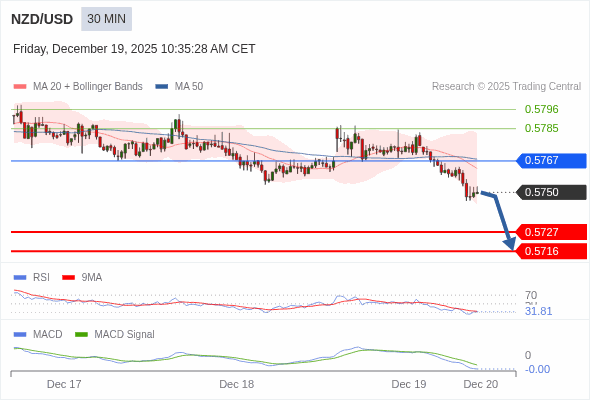NZD/USD
NZDUSD0.574USD
Today
-0.49%
5 Days
-1.11%
1 Month
+1.53%
6 Months
-4.69%
Year to Date
+2.72%
1 Year
+2.18%
Key Data Points
Opening Price
0.577Previous Closing Price
0.577Indicators
The Indicators feature provides value and direction analysis for various instruments under a selection of technical indicators, together with a technical summary.
This feature includes nine of the commonly used technical indicators: MACD, RSI, KDJ, StochRSI, ATR, CCI, WR, TRIX and MA. You may also adjust the timeframe depending on your needs.
Please note that technical analysis is only part of investment reference, and there is no absolute standard for using numerical values to assess direction. The results are for reference only, and we are not responsible for the accuracy of the indicator calculations and summaries.
NZD/USD Trading Strategy

Trading Strategy
The configuration is negative.
Alternative scenario
above 0.5767, look for 0.5785 and 0.5796.
Comment
the downside prevails as long as 0.5767 is resistance
NZD/USD News
NZD/USD weakens to near 0.5750 as upbeat GDP fails to lift Kiwi
The NZD/USD pair attracts some sellers to around 0.5760 during the early European trading hours on Friday, pressured by renewed US Dollar (USD) demand. Traders will keep an eye on the University of Michigan Consumer Sentiment Index and UoM Consumer Inflation Expectations data later on Friday.

NZD/USD posts modest gains on softer US CPI inflation
The NZD/USD pair posts modest gains near 0.5775 during the early Asian session on Friday. The US Dollar (USD) softens against the New Zealand Dollar (NZD) as softer-than-expected US inflation data raises hopes for the US Federal Reserve (Fed) rate cut.

New Zealand Trade Balance NZD (MoM) registered at $-163M above expectations ($-1175M) in November
New Zealand Trade Balance NZD (MoM) registered at $-163M above expectations ($-1175M) in November

New Zealand Exports rose from previous $6.5B to $6.99B in November
New Zealand Exports rose from previous $6.5B to $6.99B in November

New Zealand Imports dipped from previous $8.04B to $7.15B in November
New Zealand Imports dipped from previous $8.04B to $7.15B in November

New Zealand Trade Balance NZD (YoY): $-2.06B (November) vs $-2.28B
New Zealand Trade Balance NZD (YoY): $-2.06B (November) vs $-2.28B

More Details of NZD/USD
Can I trade NZD/USD through leverage?
How do interest rates affect NZD/USD?
How can traders analyze NZD/USD?
Related Instruments
Popular Symbols


